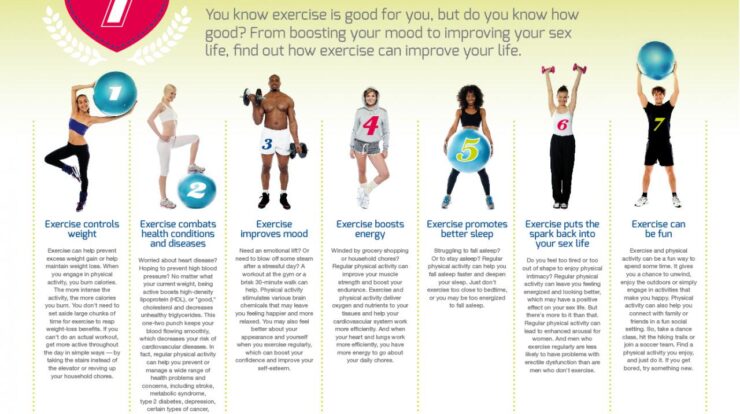
Explain why regular exercise is the best way to prevent flexibility issues. – Regular exercise is the best way to prevent flexibility issues, and this article will explain why. Flexibility is essential for maintaining a healthy range of motion, and regular exercise can help to improve and maintain flexibility at any age.
Regular exercise helps to improve flexibility by increasing the length of muscles and tendons. This allows for a greater range of motion, which can help to prevent injuries and improve overall mobility. Additionally, regular exercise can help to reduce muscle tension and stiffness, which can also contribute to improved flexibility.
Flexibility and Regular Exercise
Regular exercise is paramount for maintaining flexibility. It involves moving your joints and muscles through their full range of motion, which helps to keep them supple and prevent stiffness.
Exercises that enhance flexibility include:
- Stretching: Gently elongating muscles to improve their length and range of motion.
- Yoga: A practice that combines stretching, breathing, and meditation to enhance flexibility and balance.
- Pilates: A form of exercise that focuses on core strength, flexibility, and balance.
- Tai chi: A mind-body exercise that involves slow, gentle movements to improve flexibility, balance, and coordination.
Stretching should be incorporated into any exercise routine. It can be done before or after a workout, or as a separate activity.
The Impact of Inactivity on Flexibility
Sedentary behavior can significantly impact flexibility. When you don’t move your joints and muscles regularly, they become shorter and tighter, leading to reduced range of motion.
Inactivity can cause:
- Reduced muscle length and elasticity
- Increased joint stiffness
- Decreased range of motion
- Increased risk of injuries
It’s important to incorporate regular exercise into your routine to maintain flexibility and prevent these negative consequences.
Flexibility and Aging: Explain Why Regular Exercise Is The Best Way To Prevent Flexibility Issues.

As we age, our bodies naturally lose flexibility. This is due to several factors, including:
- Decreased production of collagen and elastin, proteins that give tissues elasticity
- Reduced muscle mass
- Changes in joint structure
Maintaining flexibility in older adults is crucial for:
- Improved mobility and range of motion
- Reduced risk of falls
- Enhanced balance and coordination
- Increased independence and quality of life
Exercises tailored for enhancing flexibility in seniors include:
- Chair yoga
- Tai chi
- Gentle stretching
- Walking
Flexibility for Different Populations
Specific populations may require targeted flexibility exercises:
- Pregnant women:Prenatal yoga and gentle stretching can help maintain flexibility and prepare for childbirth.
- Athletes:Flexibility training is essential for improving performance and reducing risk of injuries.
- Individuals with disabilities:Adapted exercises can help improve flexibility and range of motion for individuals with physical limitations.
- Individuals with chronic conditions:Flexibility exercises can alleviate pain and improve mobility for conditions such as arthritis and back pain.
Tailored exercises and modifications can be provided to meet the unique needs of these populations.
For those seeking to reduce lower back fat, specific exercises for lower back fat can be incorporated into your fitness regimen. These exercises focus on targeting the muscles in the lower back, helping to strengthen and tone the area.
The Benefits of Improved Flexibility
Enhanced flexibility offers numerous benefits:
- Improved posture:Flexible muscles support the spine and promote proper alignment.
- Enhanced balance and coordination:Flexible muscles and joints allow for better coordination and balance.
- Reduced risk of injuries:Flexible muscles and tissues are less prone to strains and sprains.
- Increased physical and mental well-being:Flexibility exercises can reduce stress, improve mood, and boost energy levels.
Regular exercise and stretching can significantly improve flexibility and contribute to overall health and well-being.
Understanding the connection between back muscles and back pain is crucial. Stiff and tight muscles can limit flexibility and mobility, leading to discomfort and potential injury. Learn how can stiff and tight muscles result in back pain? to effectively manage and prevent future issues.
Creating a Personalized Flexibility Routine

To create a personalized flexibility routine:
- Set realistic goals:Start gradually and increase intensity and duration over time.
- Incorporate exercises into daily life:Take breaks during the day to stretch or do light exercises.
- Find activities you enjoy:Choose exercises that you find enjoyable to make them more sustainable.
- Be consistent:Regular exercise is key to maintaining flexibility.
- Progress gradually:Gradually increase the intensity and duration of your exercises to avoid injuries.
By following these tips, you can create a personalized flexibility routine that fits your needs and helps you achieve your flexibility goals.
Closure
In conclusion, regular exercise is the best way to prevent flexibility issues. By incorporating regular exercise into your routine, you can help to improve your flexibility, range of motion, and overall mobility. So what are you waiting for? Get moving today!
Questions Often Asked
What are some examples of exercises that can help to improve flexibility?
Some examples of exercises that can help to improve flexibility include stretching, yoga, tai chi, and swimming.
How often should I exercise to improve my flexibility?
Strengthening your back muscles can help alleviate lower back pain and improve posture. Incorporate regular lower back exercises at home into your routine to target these muscles effectively.
To improve your flexibility, it is recommended to exercise at least twice a week.
Can I improve my flexibility if I am older?
Yes, you can improve your flexibility at any age. However, it is important to start slowly and gradually increase the intensity of your exercises over time.





